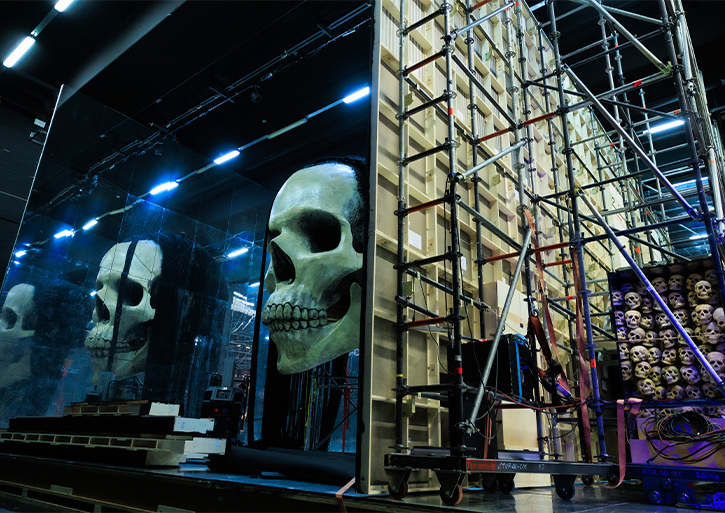
Sustainable set design
A lot of materials go into creating sets for Dutch National Opera & Ballet (DNO&B). How do we make sure to keep the environmental impact of the set designs as low as possible without compromising on artistic creativity? This is a challenge that Rolf Hauser, Head of the Production Workshop, grapples with every day.
Rolf Hauser: ‘When creating a set, there’s a difference between artwork and construction. We leave the artwork to the designers, but building the scenery is our thing. It’s up to us to make the designers’ dream come true. And we try to be as smart about that as possible. We started working with Layher, a German modular scaffolding system constructed from steel tubes, as early as in the 1990s. The system is super strong and reusable. We’re still using the modules we bought when we first started using Layher. You can hardly get more sustainable than that.’
Modular system
Layher forms the basis for DNO&B’s sets if at all possible. This saves time at the drawing board, because the draughtsmen know exactly what the standard dimensions of the modules are. Hauser: ‘Layher is used all over the world, so if one of our productions is performed abroad, we just tell the local production people which modules to use where, so they can rent them. This saves us construction time and reduces the cost of materials, transport volumes and storage fees.’

The Production Workshop tries to use as many recyclable materials as possible. Hauser: ‘We’ve already banned materials such as polyester and synthetic resin. Also, we’ve agreed with the supplier of our polystyrene that we can return any leftovers to them for reuse.’
Materials pyramid
Dutch National Opera & Ballet has put together a materials pyramid which is used as a guide for choosing materials where possible. This pyramid ranks materials by impact. Hauser: ‘The worst material, which is at the top of the pyramid, is aluminium. Bauxite mines, where aluminium ore is extracted, are extremely environmentally unfriendly. That’s a little disappointing for our set-builders, because aluminium is ultra-lightweight and it’s easy to recycle. We’re now using steel, which can also be recycled, but is much heavier.’
‘Our sawdust is pressed into briquettes, which are picked up for recycling’
Wood is at the bottom of the pyramid since it can be regrown without exhausting the ecosystem. Hauser: ‘We haven’t used tropical hardwood for at least 20 years. Our go-to wood types are European softwood, poplar wood and birch wood. Our sawdust is pressed into briquettes, which are picked up for recycling.’
At the very bottom of the pyramid are reusable materials; they are the best option. If a set is still on the roster, it is stored in the warehouse in the Noordoostpolder (in the north-east of the Netherlands) until it is needed again. After a production has been discontinued, generic set elements can be reused. But not everything will be saved, because the space at the warehouse is limited. Hauser: ‘That’s a problem for every opera house I know, and which I regularly talk about with Heads of Production Workshops of other European houses. In Germany, France and Scotland, initiatives have popped up where businesses buy up discarded sets and resell them to other opera and ballet companies. I’d like to see us join such an initiative.’
Copyright
Reusing sets can also be challenging due to copyright issues. Hauser: ‘We can’t just use elements designed by well-known artists for other productions.’
As a result, the Production Workshop can only reuse generic elements from previous sets. Hauser: ‘This means that, for the purposes of circularity, it’s best to apply as thin an artistic layer as possible. That’s a problem, though, because we’re here to create art and we want to give designers as much free reign as we can. Our house is renowned for allowing people to experiment. As set developers, we never just say no, but we might give suggestions for alternatives. Fortunately, we always manage to make it work. I look at sustainability as just another of the many practical aspects we have to consider in set construction. If it helps to protect the planet, I’m all for it.’
Text: Anne Havelaar



